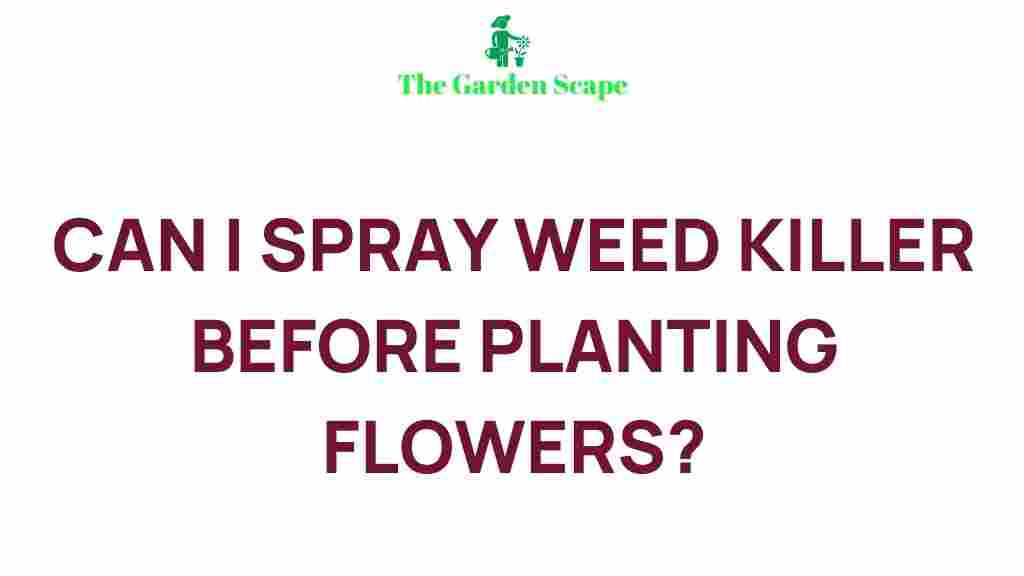Mastering the Art of Weed Killer Application Before Planting Flowers
Creating a beautiful flower garden begins with ensuring a weed-free foundation. Using a weed killer effectively before planting flowers is one of the best ways to achieve this. However, the process requires careful planning and execution to avoid harming your flowers and maintaining a thriving garden. This guide will unveil the secrets of proper weed killer application to help you cultivate a stunning and healthy flower bed.
Why Use Weed Killer Before Planting Flowers?
Weeds can compete with your flowers for nutrients, water, and sunlight, making it challenging for them to thrive. A pre-planting application of weed killer eliminates unwanted plants and prepares the soil for your flowers. This proactive approach saves you time and effort in weed removal later and ensures your garden’s aesthetics remain intact.
Types of Weed Killers
Understanding the different types of weed killer is crucial to selecting the right one for your needs:
- Pre-emergent weed killers: These prevent weed seeds from germinating. They are ideal for use several weeks before planting flowers.
- Post-emergent weed killers: These target actively growing weeds. Use these if weeds have already sprouted in your garden.
- Selective weed killers: Designed to target specific types of weeds without harming desired plants.
- Non-selective weed killers: These eliminate all plant life in the treated area and are suitable for clearing a plot before planting.
Step-by-Step Guide to Using Weed Killer
Follow these steps to ensure effective application of weed killer before planting flowers:
1. Choose the Right Weed Killer
Select a product that matches your garden’s needs. For example, if you’re dealing with a mix of broadleaf weeds and grasses, opt for a non-selective herbicide.
2. Prepare the Garden Area
Clear the garden bed of debris such as sticks and rocks. Mark areas you wish to protect, and avoid accidental contact with valuable plants.
3. Check the Weather
Apply weed killer on a calm, dry day to prevent wind drift or rain from diluting the product. The temperature should ideally be between 60°F and 85°F for maximum effectiveness.
4. Mix and Apply the Weed Killer
Follow the product label’s instructions for mixing and application. Use a sprayer for even coverage, and focus on areas with the highest weed density.
5. Wait Before Planting
Most weed killers require a waiting period before planting flowers. Check the product’s label for specific guidance. Typically, you should wait 2-3 weeks to ensure the chemicals have degraded.
Common Mistakes to Avoid
Even with the best intentions, errors can occur during the application process. Avoid these pitfalls:
- Overapplication: Using too much weed killer can harm the soil and delay planting.
- Ignoring the label: Each product has specific instructions that must be followed for effective results.
- Skipping protective gear: Always wear gloves and a mask to protect yourself from chemical exposure.
- Not waiting long enough: Planting too soon after application may harm your flowers.
Troubleshooting Weed Killer Application Issues
Sometimes, even after following the instructions, you may encounter issues. Here’s how to address them:
Problem: Weeds Resurface
Solution: Reapply a targeted post-emergent weed killer to eliminate new growth. Use mulch to suppress future weeds.
Problem: Damage to Desired Plants
Solution: Isolate the damaged area and apply organic matter to restore soil health. Protect plants during future applications by covering them with plastic sheeting.
Problem: Soil Contamination
Solution: Test your soil and apply soil amendments like compost to neutralize any chemical residues.
Additional Tips for Success
- Use natural or organic alternatives like vinegar-based weed killers for an eco-friendly approach.
- Incorporate companion planting techniques to naturally deter weeds.
- Regularly inspect your garden to catch and address weeds early.
- Explore our complete guide on flower bed preparation for more gardening tips.
Conclusion
Applying weed killer before planting flowers is a strategic way to create a weed-free and vibrant garden. By selecting the right product, following proper application techniques, and avoiding common mistakes, you can ensure your flowers thrive in a healthy environment. Always prioritize safety and environmental considerations for the best results.
For more detailed advice on sustainable gardening, visit this helpful resource. Happy gardening!
This article is in the category Garden Design and created by TheGardenScape Team
